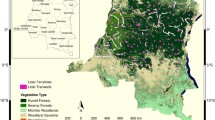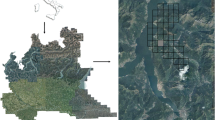Abstract
Context
Field inventory plots which usually have small sizes of around 0.25–1 ha can only represent a sample of the much larger surrounding forest landscape. Based on airborne laser scanning (LiDAR) it has been shown for tropical forests that the bias in the selection of small field plots may hamper the extrapolation of structural forest attributes to larger spatial scales.
Objectives
We conducted a LiDAR study on tropical montane forest and evaluated the representativeness of chosen inventory plots with respect to key structural attributes.
Methods
We used six forest inventory and their surrounding landscape plots on Mount Kilimanjaro in Tanzania and analyzed the similarities for mean top-of-canopy height (TCH), aboveground biomass (AGB), gap fraction, and leaf-area index (LAI). We also analyzed the similarity in gap-size frequencies for the landscape plots.
Results
Mean biases between inventory and landscape plots were large reaching as much as 77% for gap fraction, 22% for LAI or 15% for AGB. Despite spatial heterogeneity of the landscape, gap-size frequency distributions were remarkably similar between the landscape plots.
Conclusions
The study indicates that biases in field studies of forest structure may be strong. Even when mean values were similar between inventory and landscape plots, the mostly non-normally distributed probability densities of the forest variable indicated a considerable sampling error of the small field plot to approximate the forest variable in the surrounding landscape. This poses difficulties for the spatial extrapolation of forest structural attributes and for assessing biomass or carbon fluxes at larger regional scales.




Similar content being viewed by others
References
Asner GP, Scurlock JMO, Hicke JA (2003) Global synthesis of leaf area index observations: implications for ecological and remote sensing studies. Global Ecol Biogeogr 12(3):191–205
Asner GP, Powell GVN, Mascaro J, Knapp DE, Clark JK, Jacobson J, Kennedy-Bowdoin T, Balaji A, Paez-Acosta G, Victoria E, Secada L (2010) High-resolution forest carbon stocks and emissions in the Amazon. Proc Natl Acad Sci USA 107(38):16738–16742
Asner GP, Kellner JR, Kennedy-Bowdoin T, Knapp DE, Anderson C, Martin RE (2013a) Forest canopy gap distributions in the Southern Peruvian Amazon. PLoS ONE 8(4):e60875
Asner GP, Mascaro J, Anderson C, Knapp DE, Martin RE, Kennedy-Bowdoin T, van Breugel M, Davies S, Hall JS, Muller-Landau HC, Potvin C (2013b) High-fidelity national carbon mapping for resource management and REDD+. Carbon Balance Manag 8(7):1–14
Asner GP, Mascaro J (2014) Mapping tropical forest carbon: calibrating plot estimates to a simple LiDAR metric. Remote Sens Environ 140:614–624
Asner GP, Sousan S, Knapp DE, Selmants PC, Martin RE, Hughes RF, Giardina CP (2016) Rapid forest carbon assessments of oceanic islands: a case study of the Hawaiian archipelago. Carbon Balance Manag 11(1):1–13
Bonnet S, Gaulton R, Lehaire F, Lejeune P (2015) Canopy gap mapping from airborne laser scanning: an assessment of the positional and geometrical accuracy. Remote Sens-Basel 7(9):11267
Boyd DS, Hill RA, Hopkinson C, Baker TR (2013) Landscape-scale forest disturbance regimes in southern Peruvian Amazonia. Ecol Appl 23(7):1588–1602
Brown C, Burslem DF, Illian JB, Bao L, Brockelman W, Cao M, Chang LW, Dattaraja HS, Davies S, Gunatilleke CV, Gunatilleke IA (2013) Multispecies coexistence of trees in tropical forests: spatial signals of topographic niche differentiation increase with environmental heterogeneity. Proc R Soc Lond B Biol Sci 280(1764):20130502
Bustamante M, Roitman I, Aide TM, Alencar A, Anderson LO, Aragão L, Asner GP, Barlow J, Berenguer E, Chambers J, Costa MH (2016) Toward an integrated monitoring framework to assess the effects of tropical forest degradation and recovery on carbon stocks and biodiversity. Glob Change Biol 22(1):92–109
Detto M, Asner GP, Muller-Landau HC, Sonnentag O (2015) Spatial variability in tropical forest leaf area density from multireturn lidar and modeling. J Geophys Res 120(2):294–309
Dislich C, Huth A (2012) Modelling the impact of shallow landslides on forest structure in tropical montane forests. Ecol Model 239:40–53
Enquist BJ, West GB, Brown JH (2009) Extensions and evaluations of a general quantitative theory of forest structure and dynamics. Proc Natl Acad Sci USA 106(17):7046–7051
Ensslin A, Rutten G, Pommer U, Zimmermann R, Hemp A, Fischer M (2015) Effects of elevation and land use on the biomass of trees, shrubs and herbs at Mount Kilimanjaro. Ecosphere 6(3):1–15
Espírito-Santo FD, Gloor M, Keller M, Malhi Y, Saatchi S, Nelson B, Junior RC, Pereira C, Lloyd J, Frolking S, Palace M (2014) Size and frequency of natural forest disturbances and the Amazon forest carbon balance. Nat Commun 5:3434
Farrior CE, Bohlman SA, Hubbell S, Pacala SW (2016) Dominance of the suppressed: power-law size structure in tropical forests. Science 351(6269):155–157
Fischer M, Bossdorf O, Gockel S, Hänsel F, Hemp A, Hessenmöller D, Korte G, Nieschulze J, Pfeiffer S, Prati D, Renner S (2010) Implementing large-scale and long-term functional biodiversity research: the biodiversity exploratories. Basic Appl Ecol 11(6):473–485
Fischer R, Ensslin A, Rutten G, Fischer M, Costa DS, Kleyer M, Hemp A, Paulick S, Huth A (2015) Simulating carbon stocks and fluxes of an African Tropical Montane forest with an individual-based forest model. Plos ONE 10(4):e0123300
Getzin S, Dean C, He FL, Trofymow JA, Wiegand K, Wiegand T (2006) Spatial patterns and competition of tree species in a Douglas-fir chronosequence on Vancouver Island. Ecography 29(5):671–682
Getzin S, Wiegand T, Wiegand K, He F (2008) Heterogeneity influences spatial patterns and demographics in forest stands. J Ecol 96(4):807–820
Getzin S, Worbes M, Wiegand T, Wiegand K (2011) Size dominance regulates tree spacing more than competition within height classes in tropical Cameroon. J Trop Ecol 27(1):93–102
Getzin S, Nuske RS, Wiegand K (2014) Using unmanned aerial vehicles (uav) to quantify spatial gap patterns in forests. Remote Sens-Basel 6(8):6988–7004
Gossner MM, Getzin S, Lange M, Pašalić E, Türke M, Wiegand K, Weisser WW (2013) The importance of heterogeneity revisited from a multiscale and multitaxa approach. Biol Conserv 166:212–220
Harding DJ, Lefsky MA, Parker GG, Blair JB (2001) Laser altimeter canopy height profiles—methods and validation for closed-canopy, broadleaf forests. Remote Sens Environ 76(3):283–297
Hemp A (2006) Continuum or zonation? Altitudinal gradients in the forest vegetation of Mt. Kilimanjaro. Plant Ecol 184(1):27–42
Hewitt JE, Thrush SF, Dayton PK, Bonsdorff E (2007) The effect of spatial and temporal heterogeneity on the design and analysis of empirical studies of scale-dependent systems. Am Nat 169(3):398–408
Kellner JR, Clark DB, Hubbell SP (2009) Pervasive canopy dynamics produce short-term stability in a tropical rain forest landscape. Ecol Lett 12(2):155–164
Kent R, Lindsell JA, Laurin GV, Valentini R, Coomes DA (2015) Airborne LiDAR detects selectively logged Tropical forest even in an advanced stage of recovery. Remote Sens-Basel 7(7):8348–8367
Lobo E, Dalling JW (2014) Spatial scale and sampling resolution affect measures of gap disturbance in a lowland tropical forest: implications for understanding forest regeneration and carbon storage. Proc R Soc Lond B Biol Sci 281(1778):20133218
Martin AR, Thomas SC (2011) A reassessment of carbon content in tropical trees. PLoS ONE 6(8):e23533
Marvin DC, Asner GP (2016) Branchfall dominates annual carbon flux across lowland Amazonian forests. Environ Res Lett 11(9):1–11
Marvin DC, Asner GP, Knapp DE, Anderson CB, Martin RE, Sinca F, Tupayachi R (2014) Amazonian landscapes and the bias in field studies of forest structure and biomass. Proc Natl Acad Sci USA 111(48):E5224–E5232
Marvin DC, Koh LP, Lynam AJ, Wich S, Davies AB, Krishnamurthy R, Stokes E, Starkey R, Asner GP (2016) Integrating technologies for scalable ecology and conservation. Glob Ecol Conserv 7:262–275
Mascaro J, Detto M, Asner GP, Muller-Landau HC (2011) Evaluating uncertainty in mapping forest carbon with airborne LiDAR. Remote Sens Environ 115(12):3770–3774
McLean KA, Trainor AM, Asner GP, Crofoot MC, Hopkins ME, Campbell CJ, Martin RE, Knapp DE, Jansen PA (2016) Movement patterns of three arboreal primates in a Neotropical moist forest explained by LiDAR-estimated canopy structure. Landscape Ecol 31(8):1849–1862
Molina PX, Asner GP, Abadia MF, Manrique JCO, Diez LAS, Valencia R (2016) Spatially-explicit testing of a general aboveground carbon density estimation model in a Western Amazonian forest using Airborne LiDAR. Remote Sens-Basel 8(1):9
Montgomery R, Chazdon R (2002) Light gradient partitioning by tropical tree seedlings in the absence of canopy gaps. Oecologia 131(2):165–174
Punchi-Manage R, Getzin S, Wiegand T, Kanagaraj R, Savitri Gunatilleke CV, Nimal Gunatilleke IA, Wiegand K, Huth A (2013) Effects of topography on structuring local species assemblages in a Sri Lankan mixed dipterocarp forest. J Ecol 101(1):149–160
Rutten G, Ensslin A, Hemp A, Fischer M (2015) Vertical and horizontal vegetation structure across natural and modified habitat types at Mount Kilimanjaro. PLoS ONE 10(9):e0138822
Tang H, Dubayah R, Swatantran A, Hofton M, Sheldon S, Clark DB, Blair B (2012) Retrieval of vertical LAI profiles over tropical rain forests using waveform lidar at La Selva, Costa Rica. Remote Sens Environ 124:242–250
Taubert F, Jahn MW, Dobner HJ, Wiegand T, Huth A (2015) The structure of tropical forests and sphere packings. Proc Natl Acad Sci USA 112(49):15125–15129
Team RDC (2016) R: a language and environment for statistical computing. Austria, Vienna
Torimaru T, Itaya A, Yamamoto S-I (2012) Quantification of repeated gap formation events and their spatial patterns in three types of old-growth forests: analysis of long-term canopy dynamics using aerial photographs and digital surface models. For Ecol Manag 284:1–11
Vaglio Laurin G, Puletti N, Chen Q, Corona P, Papale D, Valentini R (2016) Above ground biomass and tree species richness estimation with airborne lidar in tropical Ghana forests. Int J Appl Earth Obs Geoinf 52:371–379
Acknowledgements
We are grateful to T. Nauss from the University of Marburg for providing the LiDAR data. The study was funded by the German Research Foundation (DFG) and is part of the DFG research unit FOR1246 “Kilimanjaro ecosystems under global change: linking biodiversity, biotic interactions and biogeochemical ecosystem processes”. AH and RF were supported by the Helmholtz-Alliance Remote Sensing and Earth System Dynamics. NK was funded by the German Federal Ministry for Economic Affairs and Energy (BMWi) under the funding reference 50EE1416. We thank two reviewers for their constructive comments on our paper.
Author information
Authors and Affiliations
Corresponding author
Electronic supplementary material
Below is the link to the electronic supplementary material.
Rights and permissions
About this article
Cite this article
Getzin, S., Fischer, R., Knapp, N. et al. Using airborne LiDAR to assess spatial heterogeneity in forest structure on Mount Kilimanjaro. Landscape Ecol 32, 1881–1894 (2017). https://doi.org/10.1007/s10980-017-0550-7
Received:
Accepted:
Published:
Issue Date:
DOI: https://doi.org/10.1007/s10980-017-0550-7




